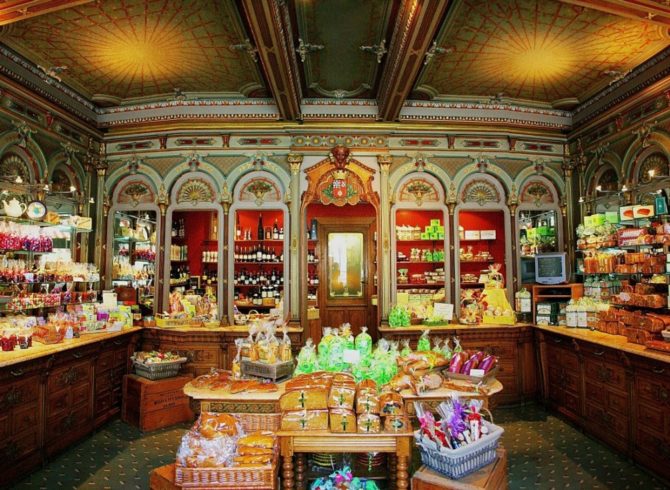Bountiful Burgundy

In this region weighted with history and blessed by the gods, it took all the ingenuity of man to turn the rich agricultural fields into even richer vineyards. Wine has been produced in Burgundy since the Roman conquest in the first century AD; Cistercian monks founded the Clos de Vougeot in the 12th century, and the medieval dukes of Burgundy pronounced themselves “princes of the best wines in Christendom”.
The vast Burgundy region, southeast of Paris and the Ile-de-France, encompasses four French départements: the Yonne in the north, the Côte d’Or in the east, Nièvre in the west and Saône-et-Loire in the south. And if the grand old province, which long defied the rival kings of France, has always been famed for its wines, it’s just as renowned for its broader traditions of hearty gastronomy. Burgundians are bon vivants ever ready to vaunt their rich culinary heritage—one eats very well in Burgundy, as anyone who has ever tasted real boeuf bourguignon can attest.
A comprehensive gourmet tour of Burgundy could take weeks on end, since it would have to cover a whole lot of ground and—in addition to the wines, of course—a score of specialties, including charcuterie, escargots, mustard, cheese, pain d’épices (spice cake), biscuits à la cuillère (ladyfingers), regional jellies and jams, cassis liqueur and various eaux-de-vie (fruit brandies). Some of these delicious delicacies can be carried home; all of them are even better tasted on their home ground in bountiful Burgundy.
Our starter list for the gourmet traveler starts with charcuterie, and the two great Burgundian classics jambon persillé and andouillette. Jambon persillé, or parslied ham, has been around since the Middle Ages, when it was known as Easter ham. Andouillette is a specialty of the charming town of Chablis in northern Burgundy near Auxerre—it’s an extremely strong and smelly sausage not for the faint of heart (and not to be confused with the Cajun andouille pork sausage found in the US).
Jambon Persillé
Nothing could be more truly Burgundian than this specialty, which originated in the vineyard towns of the Côte d’Or at Easter, to mark the end of Lenten fasting. Now found throughout the region, technically it can no longer be called ham, but simply persillé de Bourgogne, because it’s in fact made with pork shoulder that’s been salted for preservation and thus tenderized. The shoulder is cooked in a bouillon with herbs, vegetables, white wine and a bit of veal trotter for its natural jelly. The meat is drained, the veal trotter finely minced and replaced in the bouillon with garlic, vinegar, red or white wine and fresh parsley. The pork shoulder is cubed, put into a ceramic terrine or a baking dish and then layered with the gelatinous bouillon. Weights are placed on top to press it as it cools—for at least 24 hours—and there’s no need to wait for Easter to chow down. But it must always be made by the rules, and never with industrial gelatin.
Charcuterie Gaudillière, 27 rue de la République, Chagny, 03.85.87.11.49. www.charcuterie- gaudillière.fr
Charcuterie Raillard, 4 rue Monge, Beaune, 03.80.22.23.04
Andouillette
The label AAAAA (Association Amicale des Amateurs d’Andouillettes Authentiques) has been awarded to two serious producers situated side by side in Chablis, both of whom make their andouillette by the traditional rules of the art: using nothing but the morsels of the digestive tube of fresh pork, cleaned, blanched and tiré à la ficelle—that is, strips of the seasoned meat are strung together and then pulled into a natural intestinal casing. The sausages are then cooked in a court bouillon for a minimum of five hours. They can be bought at most French butcher shops, and are served grilled, either on a barbecue or in a pan, or simmered with shallots and Chablis, for example. It seems that France is the only country to make this marvel, but that’s hard to prove.
Marc Colin, 3 pl Charles de Gaulle, Chablis. 03.86.42.10.62. www.marccolin.com
Maison de l’Andouillette Michel Soulié, 3 bis pl du Général de Gaulle, Chablis, 03.86.42.12.82. www.chablis.net/maisondelandouillette
Escargots
Escargots may be the most famous of all Burgundy specialties. All over the world, people admire or deplore the crazy French mania for munching on the gardener’s worst enemy. Tradition calls for preparing snails with garlic butter and parsley, and serving them in their shells. These days, most escargots are imported, because they have become rare in Burgundy. But Corine Rubod has created a ferme hélicicole (Helix aspera is the proper name of the spiral-shelled gastropod) in Vaux, near Briant, in the Brionnais area east of Macon. She raises her snails in the fields and prepares them herself, mostly with products she grows herself. The farm is open at certain times for visits and tastings, and her website lists restaurants in the area where her escargots are served.
L’Escargot Brionnais, Vaux, near Briant, 03.85.25.86.51. www.lescargotbrionnais.free.fr
Mustard
For mustard, there is only one address. Forget Amora and Maille, both totally industrial producers, and head straight for La Moutarderie Fallot in Beaune, the last independent mustard-maker in Burgundy. Mustard seed, or sénévé, is still ground in a stone mill to keep it from overheating and safeguard all its flavor. Nearly all mustard seed now comes from Canada, but Fallot has relaunched mustard cultivation in Burgundy, and already gained an IGP label (Indication Géographique Protégée) for it.
At Fallot, the Dijon mustard is smooth and strong. For moutarde à l’ancienne, the mustard seeds are used whole. Mustard on tap, very fresh and very strong, has its fans, too. And there is an entire range of flavors—one more delicious than the other, with cassis and spice cake among the best. The factory is open for visits, and it’s not to be missed under any circumstances. 31 rue du Faubourg Bretonnière, Beaune, 03.80.22.10.02. www.fallot.com
Also in Beaune, two other things must not be missed. Should you have the chance to be anywhere nearby on the third Sunday in November, the annual charity auction of Hospices de Beaune wines is fascinating and exciting as the bidding mounts higher and higher. 2 rue de l’Hôtel Dieu, 03.80.24.45.00. www.hospices-de-beaune.com
And if the excitement of the auction or hectic pace of travel has worn you out, take a break in a spa not quite like all the others, with treatments based on grapes, full of powerful antioxidant polyphenols. Spa Bourgogne, 5 rue du Château, 03.80.21.19.91. www.spa-en-bourgogne.com
Cheese
When it comes to Burgundy cheeses, the famous fromages d’abbaye are made in medieval abbeys that have preserved their age-old custom of cheesemaking. Most often made with unpasteurized milk, the cheeses develop a characteristic and much sought-after flavor. Moreover, visits to the abbeys provide a peaceful parenthesis on a busy trip.
Epoisses gets its unique flavor from marc de Bourgogne, the regional brandy made from the lees of the wine, which gives it powerful aromas and a touch of finesse. Epoisses nearly disappeared, and probably would have without the efforts of the Berthaut family, whose traditional orange-rind soft Epoisses won its AOC in 1991.
Ferme de l’Abbaye de la Pierre-qui-Vire, 1 L’Huis Saint Benoît, Saint-Léger-Vauban, 03.86.33.03.73. www.abbaye-pierrequivire.asso.fr
Abbaye de Cîteaux, Saint- Nicolas-lès-Cîteaux, 03.80.61.34.28. www.citeaux-abbaye.com
Fromagerie Berthaut, Place du Champ-de-Foire, Epoisses, 03.80.96.44.44. www.fromagerie-berthaut.com
Pain d’Epices
The traditional Burgundian pain d’épices—sort of a cross between bread and cake—originated in China; it’s said that Genghis Khan’s warriors introduced it wherever they traveled or conquered. More directly, it arrived in Burgundy via the Middle East. The Dijon variety is made with flour, spices and aromatics such as cinnamon, nutmeg, ginger, pepper, honey, lemon or orange zest. Most is now industrial, but a few artisans have held out, offering delicious varieties with candied fruits or almonds, and the famous muffin-shaped and moist nonettes.
Mulot & Petitjean, 13 pl Bossuet, Dijon, 03.80.30.22.45; 1 pl Carnot, Beaune, 03.80.22.06.18. www.mulotpetitjean.fr
Toussaint, 154 ave Victor Hugo, Dijon, 03.80.55.11.22. www.paindepicestoussaint.com
Biscuits
There are eggs aplenty in Biscuit Grobost’s biscuits à la cuillère—literally spoon cookies, but in fact much like ladyfingers. The secret of their lightness is egg whites beaten into peaks and folded into the batter. That delicate operation is indispensable in achieving the soft airiness of these artisanal biscuits baked in a stone oven; the hundred-year-old recipe was passed down in the family. Wonderful eaten on their own, they also make superb charlottes.
Biscuits Grobost, Coeurty, Saint- Péreuse, 03.86.84.44.33. www.biscuits-grobost.com
Cassis
The black currant variety known as the Noir de Bourgogne most often winds up as crème de cassis, a sweet and very fragrant elixir much like a liqueur, with an alcohol content of 15% to 19%, famed far beyond France. Very popular thanks to the kir, the white-wine-and-cassis aperitif concocted after WWII by the Canon Félix Kir—priest, mayor of Dijon and a celebrated figure in French politics. The black currants are harvested in July and the berries macerated in alcohol for six weeks. Cassis is sipped straight, over ice or in a kir, and is also used in cooking.
Other berries and fruits are transformed into liqueurs, brandies and eaux-de-vie in Burgundy, including raspberries, grapes and pears. Sometimes the distillation is done in ambulatory stills that are trucked from one village to another, because for several years now it’s no longer been legal to improvise your own home distillery. The law is very strict—the pretext is to combat alcoholism, the real reason is to collect taxes.
Ferme Fruirouge, Concoeur, Nuits-Saint-Georges, 03.80.62.36.25. www.fruirouge.fr
Joseph Cartron, 25 rue du Docteur Louis Legrand, Nuits-Saint-Georges, 03.80.62.00.90. www.cartron.fr
Confitures
One of France’s best confituriers is found in the Morvan, in central Burgundy, in the native village of Bernard Berilley, who went into the jam-and-marmalade business some 30 years ago, turning out some 3,000 jars a year. Today it’s more like 200,000, but the fruit is still washed, peeled and checked by hand. There are some 20 flavors, and also compotes that are not as sweet. It’s all made with pure cane sugar and cooked in small copper cauldrons. One secret: seasonal fruit, exactly ripe and undamaged. Bernard remains the same, always amiable, with a slight air of the aging hippy with his long gray hair pulled into a ponytail. But make no mistake—he’s a talented pro.
La Trinquelinette, Trinquelin, hamlet of Saint-Léger-Vauban, near Quarré-les-Tombes, 03.86.32.20.97.
Where to Stay
With two winemakers known for their top-notch wines:
La Maison d’Olivier Leflaive Eleven rooms, two suites (€140–€220), table d’hôtes dining (€40–€65). 10 pl du Monument, Puligny-Montrachet, 03.80.21.95.27. www.maisonolivierleflaive. fr
Château de Chassagne-Montrachet–Domaine Michel Picard Luxury guest rooms (€250), table d’hôte (€45–€55). 5 rue du Château, Chassagne- Montrachet, 03.80.21.98.57. www.michelpicard.com
A new B&B in a historic 15th-century farmhouse:
Le Manoir Equivocal Two double rooms (€150–€170); and a cottage that sleeps 11. 18 rue du Manoir, hameau de Moux, near Nuits-Saint-Georges, 06.40.23.94.63. www.manoirequivocal.com
Where to eat
Lameloise ***36 pl d’Armes, Chagny. 03.85.87.65.65. www.lameloise.com
Le Montrachet *10 pl des Marronniers, Puligny-Montrachet, 03.80.21.30.06. www. le-montrachet.com
DZ’envies 12 rue Odebert, Dijon. 03.80.50.09.26. www.dzenvies.com
Hôtellerie du Val d’Or 140 Grande Rue, Mercurey. 03.85.45.13.70. www.le-valdor.com
Originally published in the October 2012 issue of France Today
Share to: Facebook Twitter LinkedIn Email



